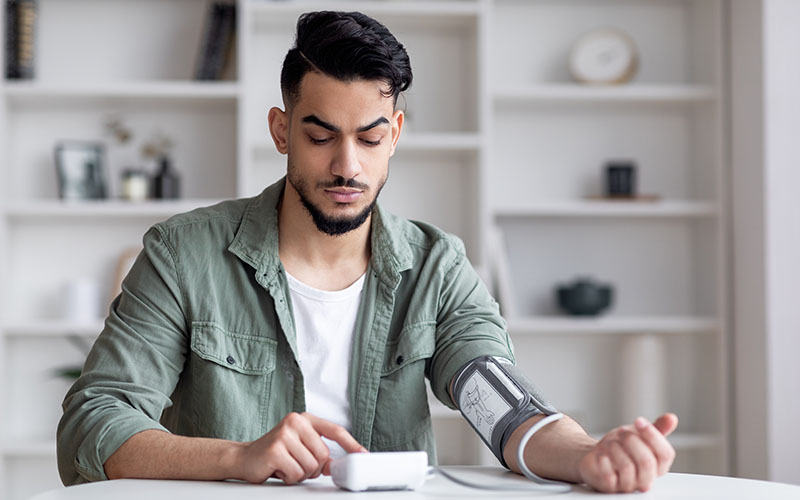
What is blood pressure?
Blood pressure is the measured force of the blood pushing against the artery walls. Each time the heart beats, it pumps blood away from your heart, into the arteries and into your body’s tissues, organs, and other body parts. The highest blood pressure is when the heart contracts. When the heart relaxes, the blood pressure falls.
What do blood pressure numbers mean?
Two numbers are recorded when measuring blood pressure. The first/upper number is called systolic pressure. It’s the pressure inside the artery when the heart contracts and pumps blood through the body—and it’s the higher number because your arteries are under more pressure when the heart contracts. The lower number is the diastolic pressure. It’s the pressure inside the artery when the heart is at rest and is filling with blood. Both pressures are recorded as “mm Hg” (millimeters of mercury).
What’s the big deal about high blood pressure?
With high blood pressure, the arteries may resist the flow of blood. This causes the heart to work harder to circulate the blood. High blood pressure directly increases the risk of heart attack, heart failure and stroke. Because it usually doesn’t have symptoms a person would notice, high blood pressure is called the silent killer.
The five blood pressure categories
- Normal blood pressure is systolic of less than 120 and diastolic of less than 80 (120/80).
- Elevated blood pressure is systolic of 120 to 129 and diastolic less than 80. If you don’t take steps to improve diet and exercise, chances are you’ll develop high blood pressure.
- Stage 1 high blood pressure is systolic is 130 to 139 or diastolic between 80 to 89. Your healthcare provider may prescribe medicine to lower your blood pressure and ask you to make lifestyle changes.
- Stage 2 high blood pressure is when systolic is 140 or higher or the diastolic is 90 or higher. Your provider will likely prescribe medicine to lower your blood pressure. Lifestyle changes alone will not be enough.
- Hypertensive crisis is when your blood pressure reaches a systolic (top number) of 180 or higher OR diastolic (bottom number) of 120 or higher—get emergency medical treatment.
These numbers should be used as a guide only. A single blood pressure measurement that is higher than normal does not necessarily mean there is a problem. Your healthcare provider will want to see multiple blood pressure measurements over several days or weeks before making a diagnosis of high blood pressure and starting treatment. Ask your provider when to contact them if your blood pressure readings are not within normal range.
Why should I monitor my blood pressure at home?
For people with high blood pressure, home monitoring allows your healthcare provider to track how much your blood pressure changes during the day, and from day to day. If you take blood pressure medicine, this may also help your provider learn how effectively it is working.
What special equipment do I need to measure blood pressure?
Your best choice is to use a digital monitor where the blood pressure reading appears on a small screen. Make sure the cuff fits your arm. Having a cuff that is too large or too small can lead to inaccurate readings. Make sure the tubing is not twisted when you store it and keep it away from heat to prevent cracks and leaks. Monitors will have to be replaced now and then. Check that your device is working correctly.
Don’t take your blood pressure on an arm or leg that has been severely injured, has had surgery on the blood vessels, or has injury to the tissue.
Before you measure your blood pressure
The American Heart Association recommends the following guidelines for home blood pressure monitoring:
- Don’t smoke, have caffeinated drinks, or exercise for 30 minutes before taking your blood pressure.
- Go to the bathroom before the test.
- Relax for 5 minutes before taking the measurement.
- Sit with your back supported (don’t sit on a couch or soft chair). Keep your feet on the floor uncrossed. Place your arm on a solid flat surface (like a table) with the upper part of the arm at heart level. Place the middle of the cuff directly above the bend of the elbow. Check the monitor’s instruction manual for an illustration.
- Take multiple readings. When you measure, take 2 to 3 readings one minute apart and record all the results.
- Take your blood pressure at the same time every day, or as your healthcare provider recommends.
- Record the date, time, and blood pressure reading.
- Take the record with you to your next medical appointment. If your blood pressure monitor has a built-in memory, simply take the monitor with you to your next appointment.
- Call your provider if you have several high readings. Don’t be frightened by a single high blood pressure reading, but if you get several high readings, check in with your healthcare provider.
Looking for a primary care provider to partner with on your well-being? Visit valleymed.org/find-a-provider.

